Contents
Best Paints for an Exterior Fiberglass Door in 2025
An exterior fiberglass door is a durable, low-maintenance choice for your home’s entryway, resisting warping, rotting, and rust compared to wood or metal. However, to maintain its appearance and protect it from harsh weather—UV rays, rain, snow, and temperature fluctuations—choosing the right paint is crucial. The best paint for a fiberglass door offers strong adhesion, flexibility, and weather resistance, ensuring a vibrant, long-lasting finish that enhances curb appeal. This guide highlights the top five paints for exterior fiberglass doors, selected for their quality, compatibility, and user feedback.
Top 5 Paints for Exterior Fiberglass Doors
1. Sherwin-Williams SnapDry Door and Trim Paint (Best Overall)
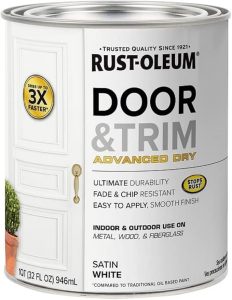
Sherwin-Williams SnapDry is a premium water-based acrylic paint designed for doors and trim, offering excellent adhesion to fiberglass and a durable, smooth finish.
Key Features:
- Type: Acrylic latex.
- Finish: Semi-gloss, satin.
- Coverage: Up to 400 sq. ft. per gallon.
- Drying Time: 1-2 hours to touch; 4-6 hours between coats; dries to prevent sticking.
- Weather Resistance: UV- and mildew-resistant; <50g/L VOC for eco-friendliness.
- Price: ~$60-$80 per gallon.
- Why It Stands Out: Fast-drying formula with excellent flow and leveling, ideal for exterior fiberglass doors.
Pros:
- No primer needed for factory-primed doors.
- Resists fading and weathering in harsh conditions.
- Easy cleanup with soap and water.
Cons:
- Premium price point.
- May require two coats for bold colors.
Best For: Homeowners seeking a professional-grade, low-maintenance paint for fiberglass doors in any climate.
2. Behr Premium Plus Ultra Exterior Paint and Primer (Best for Easy Application)
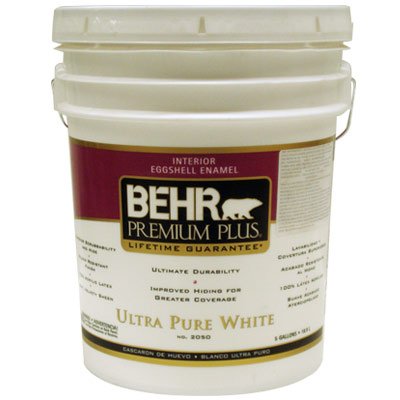
Behr’s Premium Plus Ultra is a 100% acrylic latex paint with built-in primer, making it a convenient choice for DIYers painting fiberglass doors.
Key Features:
- Type: Acrylic latex, paint-and-primer.
- Finish: Semi-gloss, satin.
- Coverage: Up to 400 sq. ft. per gallon.
- Drying Time: 1-2 hours to touch; 4-6 hours between coats.
- Weather Resistance: Mildew- and UV-resistant; low VOC.
- Price: ~$40-$60 per gallon.
- Why It Stands Out: Self-priming formula adheres well to smooth fiberglass surfaces.
Pros:
- Simplifies prep by combining paint and primer.
- Durable finish resists cracking and peeling.
- Wide color range for custom aesthetics.
Cons:
- May need a bonding primer for slick, unprimed fiberglass.
- Slightly less durable than premium options in extreme weather.
Best For: DIYers wanting a user-friendly paint with excellent coverage for fiberglass doors.
3. Valspar Duramax Exterior Paint and Primer (Best for Longevity)
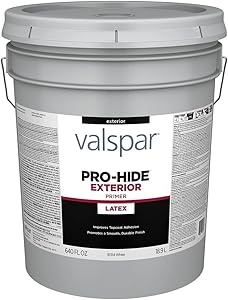
Valspar Duramax is a high-quality acrylic latex paint praised for its “lifetime” durability, making it ideal for fiberglass doors exposed to intense sun or humidity.
Key Features:
- Type: Acrylic latex, paint-and-primer.
- Finish: Semi-gloss, satin.
- Coverage: Up to 400 sq. ft. per gallon.
- Drying Time: 1-2 hours to touch; 6-8 hours between coats.
- Weather Resistance: Resists fading, cracking, and mildew; flexible for temperature changes.
- Price: ~$45-$65 per gallon.
- Why It Stands Out: Exceptional durability, with users reporting no peeling or fading after 10+ years.
Pros:
- Flexible finish withstands thermal expansion.
- Excellent adhesion to factory-primed fiberglass.
- Easy to apply with brush, roller, or sprayer.
Cons:
- Limited availability at some retailers.
- May require two coats for darker colors.
Best For: Homeowners in sunny or humid climates needing a long-lasting paint for fiberglass doors.
4. Benjamin Moore Emerald Urethane Trim Enamel (Best for Smooth Finish)
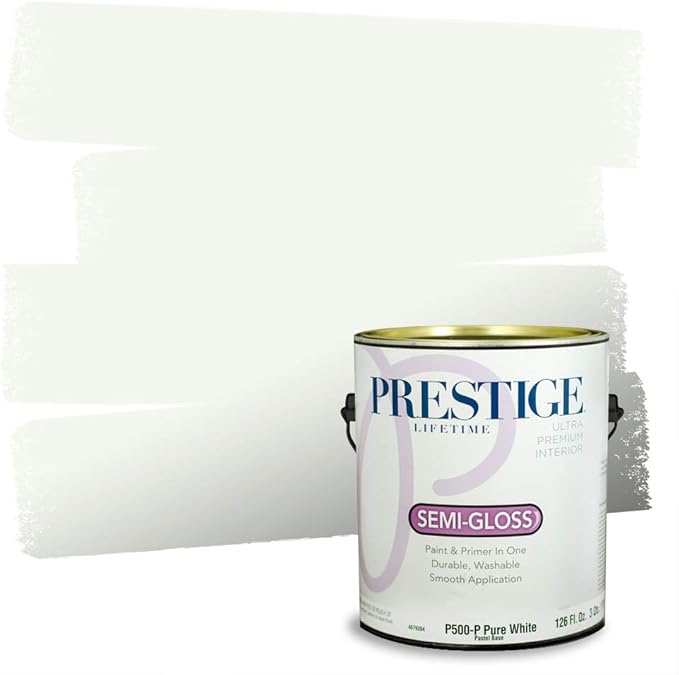
Benjamin Moore’s Emerald Urethane Trim Enamel is a water-based urethane-acrylic hybrid that delivers a smooth, oil-like finish, perfect for fiberglass doors in high-traffic areas.
Key Features:
- Type: Water-based urethane-acrylic.
- Finish: Semi-gloss, gloss.
- Coverage: Up to 450 sq. ft. per gallon.
- Drying Time: 2-4 hours to touch; 6-8 hours between coats.
- Weather Resistance: UV-resistant; blocks stains and wear.
- Price: ~$70-$90 per gallon.
- Why It Stands Out: Provides a durable, glossy finish with excellent color retention.
Pros:
- Smooth, professional finish mimics oil-based paints.
- Resists dings and scratches on busy doors.
- Low VOC for eco-conscious users.
Cons:
- Expensive compared to standard acrylics.
- Requires a bonding primer for unprimed fiberglass.
Best For: Professionals or homeowners seeking a high-end, durable finish for south-facing fiberglass doors.
5. Rust-Oleum Marine Topside Paint (Best for Harsh Conditions)

Rust-Oleum Marine Topside Paint is a durable oil-based paint designed for marine environments, making it a robust choice for fiberglass doors in coastal or extreme weather areas.
Key Features:
- Type: Oil-based.
- Finish: Semi-gloss.
- Coverage: Up to 100 sq. ft. per quart.
- Drying Time: 2-4 hours to touch; 24 hours between coats.
- Weather Resistance: UV-, saltwater-, and weather-resistant.
- Price: ~$25-$35 per quart.
- Why It Stands Out: Formulated for extreme durability, ideal for high-exposure doors.
Pros:
- Exceptional resistance to sun, salt, and moisture.
- Adheres well to fiberglass with proper priming.
- Smaller cans suit single-door projects.
Cons:
- Oil-based formula requires mineral spirits cleanup.
- Limited color options (e.g., white, navy).
Best For: Coastal homeowners or those in extreme climates needing maximum protection for fiberglass doors.
Key Considerations for Choosing Paint for Exterior Fiberglass Doors
Paint Type
- Acrylic Latex: Water-based, flexible, and easy to clean (e.g., Sherwin-Williams, Behr). Best for most fiberglass doors due to adhesion and weather resistance.
- Urethane-Acrylic Hybrids: Combine acrylic flexibility with urethane durability (e.g., Benjamin Moore Emerald). Ideal for high-traffic or sun-exposed doors.
- Oil-Based: Durable and smooth but slower-drying and harder to clean (e.g., Rust-Oleum Marine). Suited for extreme conditions but less common for fiberglass.
- Polyester/Polyurethane/Epoxy: Specialty paints matching fiberglass resin types (e.g., epoxy resin doors need epoxy paint). Check manufacturer guidelines.
- Avoid: Lacquer or interior-only paints, which lack weather resistance and may peel.
Finish
- Semi-Gloss: Most durable, easy to clean, and masks imperfections (e.g., Sherwin-Williams SnapDry). Ideal for high-traffic doors.
- Satin: Subtle sheen, good for hiding minor flaws (e.g., Valspar Duramax). Suits traditional or minimalist aesthetics.
- Gloss: Bold and sleek but highlights imperfections; less common for fiberglass.
- Flat: Hides dings but less durable and harder to clean; not recommended for exterior doors.
Weather and UV Resistance
- Fiberglass doors face sun, rain, and humidity. Choose paints with UV and mildew resistance (e.g., Valspar Duramax, Rust-Oleum Marine) to prevent fading and mold.
- South-facing doors need extra UV protection (e.g., Benjamin Moore Emerald). Light colors (white, gray) resist fading better than dark shades (red, navy).
Primer Requirements
- Factory-Primed Doors: No primer needed; clean and paint directly (e.g., Sherwin-Williams SnapDry).
- Unprimed or Slick Fiberglass: Use a bonding primer (e.g., Sherwin-Williams PrepRite Bonding Primer, Zinsser Smart Prime) for adhesion.
- Previously Painted Doors: Sand lightly and spot-prime bare areas. If switching from oil-based to latex, use a conversion primer (e.g., INSL-X Stix).
- Gel Stain Option: For a wood-like look, use an opaque gel stain (e.g., Minwax Gel Stain) with a clear varnish topcoat. Avoid transparent stains on fiberglass.
Application Method
- Brush: Best for detailed panels and edges; use a synthetic bristle brush for latex paints.
- Roller: Mini rollers ensure a smooth finish on flat surfaces.
- Sprayer: HVLP sprayers provide a flawless coat but require skill and overspray protection.
- Apply 2-3 thin coats for even coverage, avoiding drips.
Climate and Color
- Climate: In humid areas, prioritize mildew resistance (e.g., Behr). In sunny regions, choose UV-resistant paints (e.g., Rust-Oleum Marine).
- Color: Bold colors (red, blue) make a statement but may fade faster. Neutral tones (gray, white) are timeless and durable. Check HOA rules and match your home’s exterior.
How to Paint an Exterior Fiberglass Door
Materials Needed
- Paint (e.g., Sherwin-Williams SnapDry, Valspar Duramax) and primer (e.g., Zinsser Smart Prime, if needed).
- Sandpaper (120-220 grit) or Scotch-Brite pad, safety glasses, gloves.
- Cleaner (TSP or vinegar-water solution), acetone for wiping.
- Painter’s tape, drop cloth, mask, goggles.
- Synthetic bristle brush, mini roller, or HVLP sprayer.
- Soap/water (for latex) or mineral spirits (for oil-based).
Steps
- Check Weather: Paint on a dry day between 50-90°F, with humidity 65-70% and no direct sunlight. Substrate temperature must not exceed 120°F.
- Prepare the Surface:
- Remove hardware (knobs, locks) or tape off. Lay the door flat on sawhorses or work in place.
- Clean with TSP or vinegar-water to remove dirt, grease, and mildew. Rinse and dry thoroughly.
- Lightly sand (120-220 grit or Scotch-Brite) to scuff the surface for adhesion. Wipe with acetone to remove dust; avoid hydrocarbon solvents.
- Mask and Protect: Tape glass, hinges, and frames; use a drop cloth to protect surroundings.
- Prime (if Needed):
- Apply Paint:
- Stir paint gently to avoid bubbles. Start at the top, painting panels first, then vertical stiles, and horizontal rails, using smooth, even strokes.
- Use a brush for edges and a mini roller for flat areas. Apply thin coats, drying 4-8 hours between coats (per manufacturer’s instructions). Two coats are usually enough; three for bold colors.
- Check and Finish: Inspect for drips or uneven areas. Partially open the door during drying to prevent sticking. Remove tape carefully, using a utility knife if needed.
- Cleanup: Clean tools with soap and water (latex) or mineral spirits (oil-based). Store leftovers in a cool, dry place.
Pro Tips
- Paint All Six Sides: Coat the top, bottom, and edges to prevent moisture ingress, especially for bored doors.
- Test Color: Buy a sample to test under outdoor lighting, as colors may vary.
- Avoid Overloading: Apply thin coats to prevent drips; don’t overbrush.
- Maintenance: Clean annually with mild detergent. Repaint every 3-5 years or when fading occurs.
9 Frequently Asked Questions
1. What type of paint is best for exterior fiberglass doors?
100% acrylic latex paints (e.g., Sherwin-Williams SnapDry, Behr) are ideal for their adhesion, flexibility, and weather resistance. Urethane-acrylic hybrids (e.g., Benjamin Moore Emerald) offer extra durability, while oil-based paints (e.g., Rust-Oleum Marine) suit extreme conditions.
2. Do I need a primer for a fiberglass door?
Factory-primed doors don’t require primer; clean and paint directly (e.g., Valspar Duramax). Unprimed or slick fiberglass needs a bonding primer (e.g., Zinsser Smart Prime) for adhesion.
3. Can I use oil-based paint on a fiberglass door?
Yes, oil-based paints (e.g., Rust-Oleum Marine) work well but dry slowly and require solvent cleanup. Acrylic latex is preferred for ease and durability unless extreme conditions demand oil-based.
4. What finish is best for a fiberglass door?
Semi-gloss (e.g., Sherwin-Williams SnapDry) is most durable, easy to clean, and masks imperfections. Satin (e.g., Valspar Duramax) offers a softer look but is still weather-resistant. Avoid flat finishes for exterior doors.
5. How many coats of paint are needed?
Two thin coats provide even coverage and durability. A third coat may be needed for bold colors or to achieve full opacity.
6. Can I use a sprayer to paint a fiberglass door?
Yes, an HVLP sprayer (e.g., Wagner) delivers a smooth finish, ideal for fiberglass. Brush and roller work well for detailed areas but require more time. Protect against overspray.
7. How long does paint last on a fiberglass door?
High-quality paints (e.g., Valspar Duramax, Benjamin Moore Emerald) last 3-5 years with proper prep and maintenance, up to 10+ years in ideal conditions.
8. Can I stain a fiberglass door instead of painting?
Yes, use an opaque gel stain (e.g., Minwax Gel Stain) with a clear varnish topcoat for a wood-like look. Transparent stains don’t work on fiberglass.
9. Should I hire a professional to paint my fiberglass door?
DIY is feasible with proper prep and tools, but professionals (e.g., local painters, $25-$100/hour) ensure flawless results for complex doors, bold colors, or if you lack time.
Conclusion
Painting your exterior fiberglass door is a rewarding way to refresh your home’s entryway while protecting it from the elements. The Sherwin-Williams SnapDry Door and Trim Paint is the best overall for its fast-drying, durable finish, while Behr Premium Plus Ultra simplifies application with its paint-and-primer formula. Valspar Duramax excels for longevity, Benjamin Moore Emerald Urethane delivers a premium smooth finish, and Rust-Oleum Marine Topside thrives in harsh conditions. With proper prep cleaning, sanding, and priming as needed and these top paints, you’ll achieve a vibrant, lasting result.

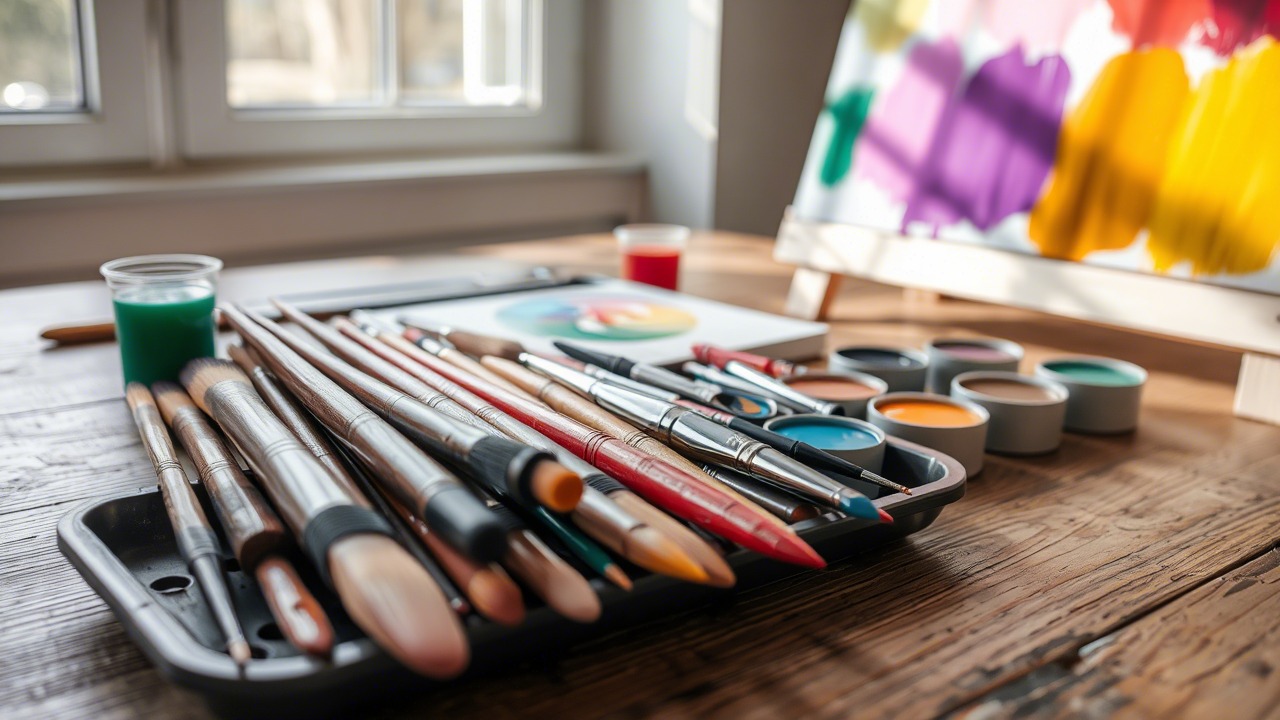
Leave a Reply